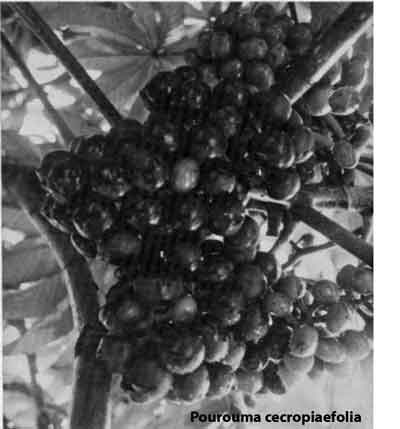
UVILLA
SCIENTIFIC NAME: Pourouma cecropiaefolia
FAMILY: Urticaceae
Uvilla (pronounced oo-vee-lya), Amazon Grape, is a tree of the Amazon region of South America. It grows best within Latitude 17° North and South of the Equator. In the Mossman, north Queensland area, for best results, grow below 200 metres.
The uvilla was introduced to North Queensland in 1978. Records of trees planted on the 10th August that same year show that: flowers first appeared by 5th August, 1980; fruits were fully developed and some had started to ripen by 15th October, 1980.
For the past five years, uvilla has performed well in the area. It crops heavily over a long period - six months and sometimes more, the main crop being from October to March. It produces large bunches of purple fruit up to 4 cm. in size, with one seed. The male flower first appears light cream in colour then turns to brown, giving off a fine powder pollen if shaken.
Young plants can be planted in the field when 20 cm high, and grow very fast For a successful fruit set, care must be taken to plant at least one male tree to every three female trees. Close planting and thinning out when the sex of the trees is determined, is the best method, as the uvilla is dioecious i.e. male and female flowers are borne on different plants.

The fruit quality can vary from trees grown in different types of soil. In rocky hill-side areas, it does produce a sweeter, but less juicy fruit; where in low-lying heavy loam soil, fruit have lots of juice with poor flavour. The uvilla does well in all types of soils. When planted in dry or hill-side locations (to develop fruit to full size) watering is necessary during the dryer part of the year.
Even with its hard skin it is not free from bird and insect attack. Flying foxes love them. Silvereye puncture fruit and suck the juice. Elephant beetles go on a rampage among bunches. Fruit sucking moths, fruit fly and shield bugs home-in, with the result that no fruit were picked from those trees left undamaged.
The wood is of a soft type, with a cork area in the center. Sometimes it requires fruit thinning so that branches don't snap and also to maintain the trees attractive and complete appearance. The fruit, besides being consumed raw, can be used in wine-making. Almost anything organic can be fermented to make wine. Uvilla, for tropical fruit wine-making, would probably rate among the tops. Through the ages man has used wine in worship to gods; in the book of Proverbs there is this sage advice "Give strong drink to him who is perishing, and wine to those in bitter distress: let them drink and forget their poverty and remember their misery no more". Who knows, perhaps one day we may have a wine of world-wide recognition. An excellent book for wine-making is Step By Step Winemaking by Mary Carey.
For fertilizer and care requirements. Apply G.F. 'Organo Fruit' at least twice a year. A light application of molasses showed an improvement in fruit quality and the tree maintained healthy, even colouring from year to year. Too much molasses can be harmful if put too close to the tree. Spray with copper-oxy before and after the wet season. Spray with Dithane M45 in August. Spray Wettable Sulphur during stages of fruit development, starting in late September, to assist in some pest deterrent.
DATE: September 1985
* * * * * * * * * * * * *
